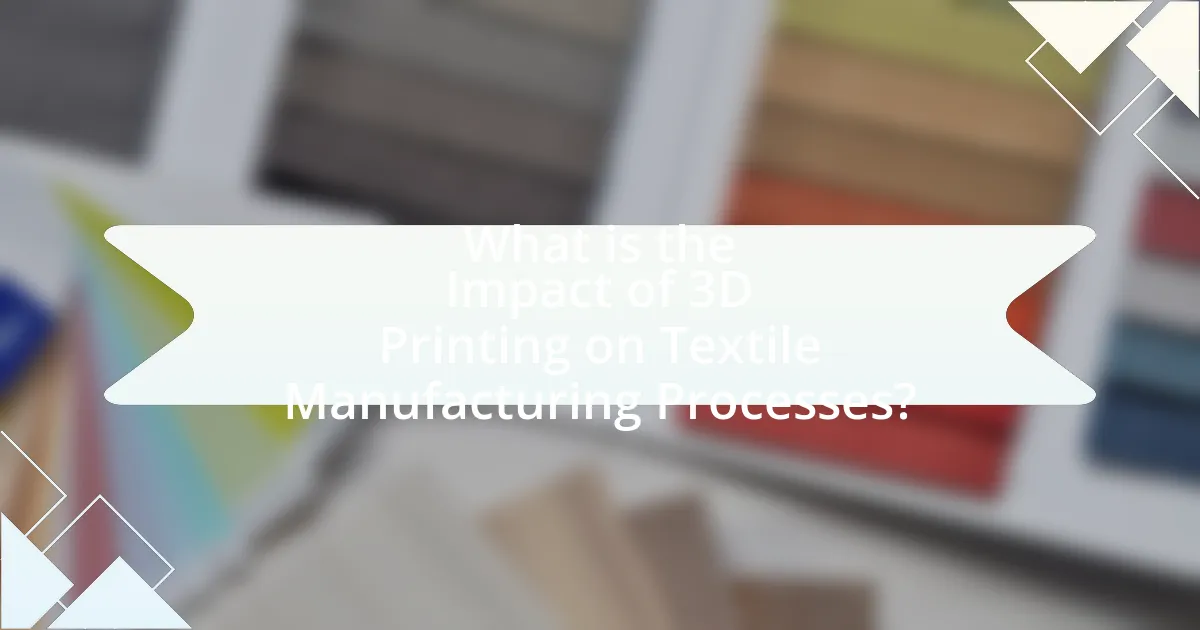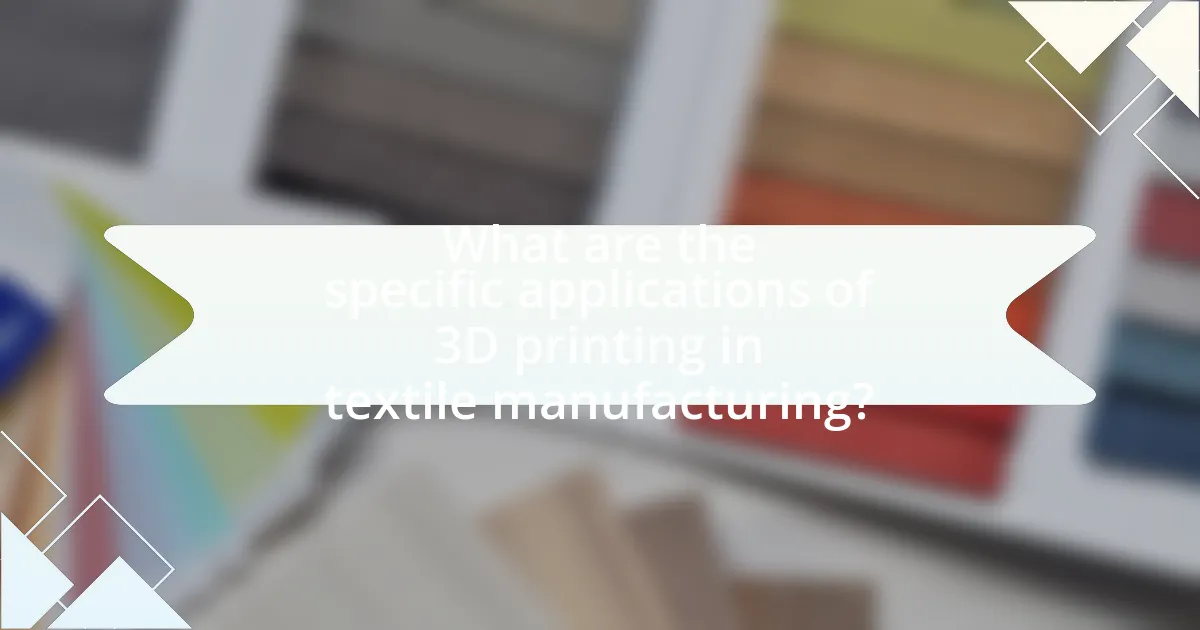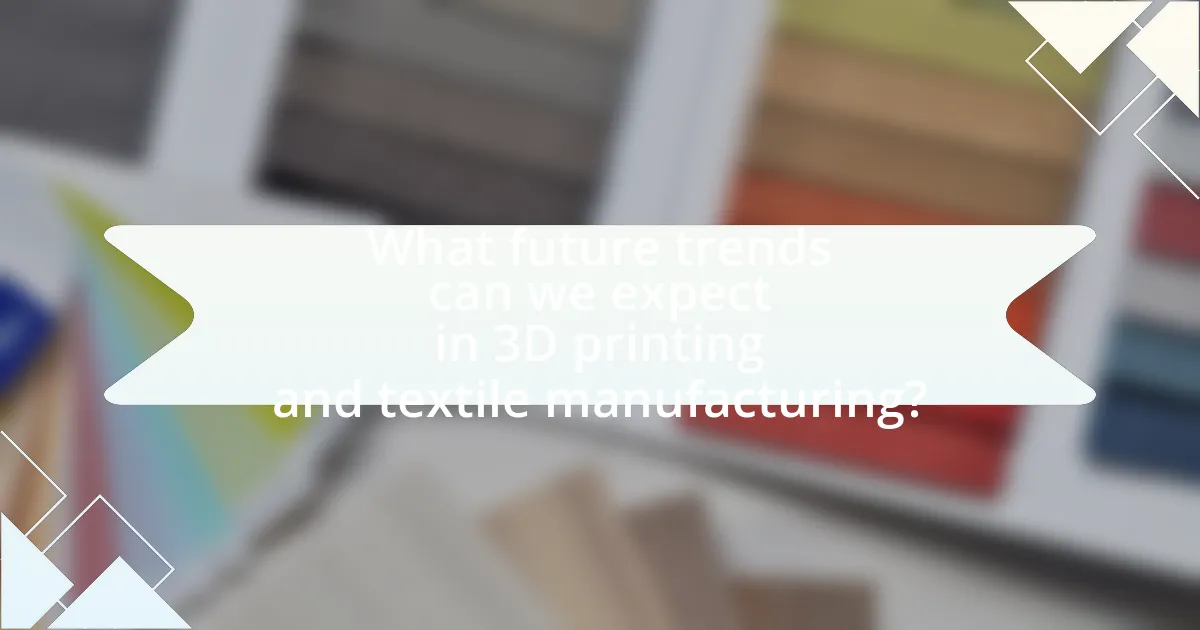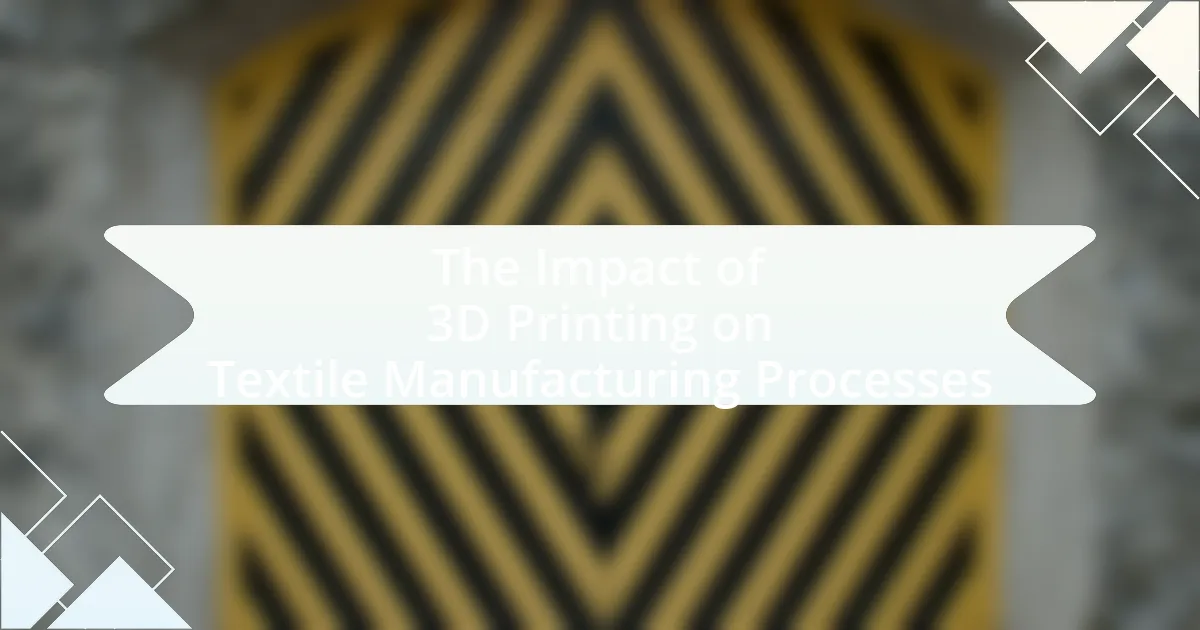The article examines the transformative impact of 3D printing on textile manufacturing processes, highlighting advancements in customization, sustainability, and design flexibility. It discusses how 3D printing enables rapid prototyping, reduces material waste by up to 90%, and facilitates on-demand production, thereby minimizing inventory costs. Key advancements in materials and techniques are explored, along with the challenges faced by the industry, such as high material costs and technical expertise requirements. The article also addresses the environmental benefits of 3D printing, including reduced waste and energy consumption, and outlines future trends that may shape the textile industry.

What is the Impact of 3D Printing on Textile Manufacturing Processes?
3D printing significantly transforms textile manufacturing processes by enabling rapid prototyping, customization, and reduced waste. This technology allows manufacturers to create intricate designs and patterns that traditional methods cannot achieve, enhancing creativity and innovation in textile production. For instance, a study published in the Journal of Textile Science & Engineering highlights that 3D printing can reduce material waste by up to 90% compared to conventional cutting methods, thereby promoting sustainability. Additionally, 3D printing facilitates on-demand production, which minimizes inventory costs and allows for personalized products tailored to consumer preferences.
How has 3D printing technology evolved in textile manufacturing?
3D printing technology has significantly evolved in textile manufacturing by enabling the production of complex, customized designs that were previously unattainable through traditional methods. Initially, 3D printing in textiles focused on prototyping and small-scale production, but advancements in materials and printing techniques have expanded its application to include functional garments and accessories. For instance, the development of flexible filaments and bio-based materials has allowed for the creation of wearable textiles that integrate both aesthetics and performance. Additionally, companies like Adidas have utilized 3D printing to produce customized footwear, demonstrating the technology’s ability to meet individual consumer needs while reducing waste. This evolution reflects a broader trend towards sustainable manufacturing practices and the integration of digital technologies in the textile industry.
What are the key advancements in 3D printing relevant to textiles?
Key advancements in 3D printing relevant to textiles include the development of advanced materials, such as flexible filaments and bio-based polymers, which enable the creation of intricate and customizable textile designs. Additionally, innovations in digital textile printing techniques allow for direct printing on fabrics, enhancing design capabilities and reducing waste. Research has shown that these advancements facilitate on-demand production, significantly decreasing lead times and inventory costs in the textile industry. For instance, a study published in the Journal of Textile Science and Engineering highlights how 3D printing can produce complex textile structures that traditional methods cannot achieve, thereby expanding design possibilities and functional applications in fashion and technical textiles.
How do these advancements change traditional textile manufacturing methods?
Advancements in 3D printing significantly alter traditional textile manufacturing methods by enabling the production of complex designs and customized fabrics that were previously difficult or impossible to achieve. Traditional methods often rely on linear processes such as weaving or knitting, which limit design flexibility and require extensive labor and time. In contrast, 3D printing allows for the direct creation of intricate patterns and structures in a single step, reducing material waste and production time. For instance, a study by the Massachusetts Institute of Technology demonstrated that 3D printing can produce textiles with varying textures and functionalities, showcasing the technology’s ability to innovate beyond conventional fabric production. This shift not only enhances design capabilities but also promotes sustainability by minimizing excess material usage.
What are the primary benefits of integrating 3D printing into textile manufacturing?
Integrating 3D printing into textile manufacturing offers significant benefits, including customization, reduced waste, and faster production times. Customization allows manufacturers to create unique designs tailored to individual consumer preferences, enhancing product appeal. The technology minimizes material waste by using only the necessary amount of fabric, which is crucial in an industry often criticized for its environmental impact. Additionally, 3D printing accelerates production processes, enabling quicker turnaround times for new designs, which is essential in the fast-paced fashion market. These advantages collectively improve efficiency and sustainability in textile manufacturing.
How does 3D printing enhance design flexibility in textiles?
3D printing enhances design flexibility in textiles by allowing for the creation of complex geometries and customized patterns that traditional manufacturing methods cannot achieve. This technology enables designers to experiment with intricate designs, varying textures, and personalized fits, which can be tailored to individual consumer preferences. For instance, a study published in the journal “Textile Research Journal” highlights that 3D printing can produce lightweight structures with optimized performance characteristics, demonstrating significant advancements in design capabilities.
What cost savings can be achieved through 3D printing in textile production?
3D printing in textile production can achieve significant cost savings by reducing material waste, lowering labor costs, and minimizing inventory expenses. Traditional textile manufacturing often results in up to 30% material waste due to cutting and sewing processes, whereas 3D printing utilizes only the necessary amount of material, leading to a more efficient use of resources. Additionally, 3D printing automates production, which can decrease labor costs by up to 50% as fewer workers are needed for assembly and finishing tasks. Furthermore, on-demand production capabilities reduce the need for large inventories, allowing companies to save on storage costs and decrease the risk of overproduction. These factors collectively contribute to substantial cost reductions in the textile manufacturing process.
What challenges does the textile industry face with 3D printing adoption?
The textile industry faces significant challenges with 3D printing adoption, primarily including high material costs, limited production speed, and technical expertise requirements. High-quality 3D printing materials, such as specialized filaments, can be expensive, which impacts overall production costs. Additionally, the speed of 3D printing is often slower compared to traditional textile manufacturing methods, making it less viable for large-scale production. Furthermore, the industry lacks sufficient technical expertise and knowledge to effectively implement and maintain 3D printing technologies, which hinders widespread adoption. These challenges collectively impede the integration of 3D printing into textile manufacturing processes.
What are the technical limitations of 3D printing in textiles?
The technical limitations of 3D printing in textiles include restricted material options, limited scalability, and challenges in achieving desired fabric properties. Current 3D printing technologies primarily utilize thermoplastics, which may not replicate the softness, flexibility, and breathability of traditional textiles. Additionally, the scalability of 3D printing for mass production remains a challenge, as the process is often slower compared to conventional textile manufacturing methods. Furthermore, achieving specific fabric characteristics, such as texture and durability, can be difficult due to the layer-by-layer construction method, which may result in weaker seams and less cohesive structures. These limitations hinder the widespread adoption of 3D printing in the textile industry.
How do regulatory and sustainability concerns impact 3D printing in textiles?
Regulatory and sustainability concerns significantly influence 3D printing in textiles by necessitating compliance with environmental standards and promoting the use of eco-friendly materials. Regulations often require manufacturers to adhere to guidelines that limit harmful emissions and waste, which can drive innovation in material development, such as biodegradable filaments. For instance, the European Union’s REACH regulation mandates the registration of chemical substances, impacting the types of materials that can be used in 3D printing. Additionally, sustainability concerns push companies to adopt practices that reduce their carbon footprint, leading to increased interest in recycling and the use of renewable resources in the production process. This shift not only aligns with consumer demand for sustainable products but also enhances the overall efficiency of textile manufacturing by minimizing resource consumption and waste generation.
How does 3D printing influence the supply chain in textile manufacturing?
3D printing significantly influences the supply chain in textile manufacturing by enabling on-demand production, which reduces inventory costs and lead times. This technology allows manufacturers to create customized products directly from digital designs, minimizing the need for large-scale production runs and excess stock. According to a study by the Massachusetts Institute of Technology, 3D printing can decrease supply chain complexity by allowing localized production, which reduces transportation costs and carbon footprint. Additionally, it facilitates rapid prototyping, enabling quicker iterations and faster response to market trends, thereby enhancing overall efficiency in the textile supply chain.
What role does 3D printing play in customization and personalization of textile products?
3D printing significantly enhances the customization and personalization of textile products by enabling the production of unique designs tailored to individual preferences. This technology allows for intricate patterns, textures, and shapes that traditional manufacturing methods cannot achieve, facilitating the creation of bespoke items that meet specific consumer demands. For instance, companies like Adidas have utilized 3D printing to produce customized footwear that conforms to the wearer’s foot shape, demonstrating the practical application of this technology in personalizing textile products.

What are the specific applications of 3D printing in textile manufacturing?
3D printing in textile manufacturing is specifically applied in creating customized fabrics, producing intricate patterns, and developing functional textiles with embedded technology. Customized fabrics allow for tailored designs that meet individual consumer preferences, enhancing personalization in fashion. The production of intricate patterns enables designers to create complex structures that traditional methods cannot achieve, leading to innovative textile designs. Additionally, functional textiles can incorporate sensors or other technologies directly into the fabric, providing enhanced performance features such as moisture-wicking or temperature regulation. These applications demonstrate the transformative potential of 3D printing in revolutionizing textile manufacturing processes.
How is 3D printing used in creating prototypes for textile products?
3D printing is utilized in creating prototypes for textile products by enabling rapid production of intricate designs and structures that can be tested for functionality and aesthetics. This technology allows designers to create customized samples quickly, reducing the time and cost associated with traditional prototyping methods. For instance, companies like Adidas have employed 3D printing to develop shoe prototypes, allowing for precise adjustments in design and fit before mass production. This approach not only accelerates the design process but also facilitates innovation in textile applications, as it enables the exploration of complex geometries and materials that would be difficult to achieve through conventional manufacturing techniques.
What materials are commonly used in 3D printing for textiles?
Common materials used in 3D printing for textiles include thermoplastic elastomers (TPE), nylon, and polyester. TPE is favored for its flexibility and durability, making it suitable for wearable applications. Nylon is known for its strength and versatility, often used in producing intricate designs and functional textiles. Polyester, recognized for its moisture-wicking properties, is frequently utilized in sportswear and activewear. These materials enable the creation of innovative textile products that enhance functionality and design in the textile manufacturing process.
How does prototyping with 3D printing reduce time to market for textile products?
Prototyping with 3D printing significantly reduces time to market for textile products by enabling rapid design iterations and immediate production of samples. Traditional prototyping methods often involve lengthy processes such as manual crafting or tooling, which can take weeks or months. In contrast, 3D printing allows designers to quickly create and modify prototypes in a matter of hours, facilitating faster feedback and adjustments. This speed in prototyping accelerates the overall development cycle, allowing companies to bring their textile products to market more efficiently. For instance, a study by Wohlers Associates reported that 3D printing can reduce product development time by up to 75%, demonstrating its effectiveness in expediting the textile manufacturing process.
What innovative products have emerged from 3D printing in textiles?
Innovative products that have emerged from 3D printing in textiles include customizable footwear, intricate fashion garments, and functional sportswear. Customizable footwear, such as Adidas’ Futurecraft 4D, utilizes 3D printing to create personalized midsoles tailored to individual foot shapes, enhancing comfort and performance. Intricate fashion garments, like those produced by designers such as Iris van Herpen, showcase complex structures and patterns that traditional manufacturing methods cannot achieve, pushing the boundaries of design. Additionally, functional sportswear, exemplified by brands like Under Armour, incorporates 3D-printed elements for improved breathability and flexibility, demonstrating the technology’s versatility in enhancing textile performance. These products illustrate the transformative impact of 3D printing on the textile industry, enabling greater customization, design innovation, and functionality.
How are fashion designers utilizing 3D printing in their collections?
Fashion designers are utilizing 3D printing to create intricate and customizable garments and accessories. This technology allows designers to produce complex structures that traditional manufacturing methods cannot achieve, enabling unique designs that enhance creativity and personalization. For instance, brands like Iris van Herpen have incorporated 3D-printed elements into their haute couture collections, showcasing the ability to create lightweight, sculptural pieces that push the boundaries of fashion. Additionally, 3D printing reduces waste by allowing for on-demand production, aligning with sustainable practices in the industry.
What are some examples of functional textiles produced through 3D printing?
Functional textiles produced through 3D printing include moisture-wicking fabrics, breathable mesh materials, and customizable orthopedic supports. For instance, researchers have developed moisture-wicking textiles that enhance comfort during physical activities by rapidly transporting sweat away from the body. Additionally, 3D printing enables the creation of breathable mesh structures that improve airflow and ventilation in clothing, making them suitable for sportswear. Customizable orthopedic supports, such as insoles and braces, can be tailored to individual anatomical needs, providing better support and comfort. These examples illustrate the innovative applications of 3D printing in creating functional textiles that enhance performance and user experience.
How does 3D printing contribute to sustainable practices in textile manufacturing?
3D printing contributes to sustainable practices in textile manufacturing by significantly reducing material waste and enabling on-demand production. Traditional textile manufacturing often results in excess fabric waste, with estimates suggesting that up to 15% of materials are discarded during the cutting process. In contrast, 3D printing utilizes only the necessary amount of material, as it builds items layer by layer, which minimizes waste. Additionally, 3D printing allows for customization and small-batch production, reducing the need for large inventories and the associated environmental impact of overproduction. This shift towards more efficient production methods aligns with sustainability goals in the textile industry.
What are the environmental benefits of using 3D printing in textiles?
The environmental benefits of using 3D printing in textiles include reduced waste, lower energy consumption, and the ability to use sustainable materials. 3D printing minimizes material waste by producing items layer by layer, which contrasts with traditional methods that often result in significant offcuts; studies indicate that additive manufacturing can reduce waste by up to 90%. Additionally, 3D printing typically requires less energy, as it can produce complex designs without the need for extensive machinery and tooling. Furthermore, advancements in 3D printing technology allow for the use of biodegradable and recycled materials, promoting a circular economy in the textile industry.
How does 3D printing reduce waste in textile production processes?
3D printing reduces waste in textile production processes by enabling precise manufacturing that minimizes excess material usage. Traditional textile production often involves cutting patterns from large fabric rolls, resulting in significant off-cuts and waste. In contrast, 3D printing allows for the creation of garments and accessories layer by layer, using only the necessary amount of material required for each item. This method can reduce material waste by up to 90%, as reported in studies examining the efficiency of additive manufacturing in the fashion industry. Additionally, 3D printing facilitates on-demand production, which further decreases overproduction and the associated waste from unsold inventory.

What future trends can we expect in 3D printing and textile manufacturing?
Future trends in 3D printing and textile manufacturing include increased customization, sustainability, and integration of smart technologies. Customization will allow consumers to design unique garments tailored to their preferences, as advancements in 3D printing technology enable rapid prototyping and production. Sustainability will be enhanced through the use of biodegradable materials and reduced waste, as 3D printing allows for on-demand production, minimizing excess inventory. Additionally, the integration of smart technologies, such as IoT and AI, will facilitate automated processes and data-driven decision-making, improving efficiency and responsiveness in textile manufacturing. These trends are supported by industry reports indicating a projected growth of the 3D printing market in textiles, expected to reach $1.2 billion by 2025, highlighting the sector’s evolving landscape.
How might advancements in 3D printing technology shape the future of textiles?
Advancements in 3D printing technology are likely to revolutionize the textile industry by enabling the production of complex, customized fabrics and garments on demand. This technology allows for the creation of intricate designs that traditional manufacturing methods cannot achieve, leading to reduced waste and increased efficiency. For instance, 3D printing can produce textiles with embedded functionalities, such as moisture-wicking or temperature regulation, enhancing performance wear. Additionally, the ability to print textiles directly from digital designs can significantly shorten lead times and reduce inventory costs, as seen in companies like Adidas, which has already implemented 3D printing in its production processes.
What emerging technologies could complement 3D printing in textiles?
Emerging technologies that could complement 3D printing in textiles include digital textile printing, smart textiles, and nanotechnology. Digital textile printing allows for high-resolution designs and patterns to be printed directly onto fabrics, enhancing customization and reducing waste. Smart textiles incorporate sensors and electronics into fabrics, enabling functionalities such as temperature regulation and health monitoring, which can be integrated with 3D-printed components for advanced applications. Nanotechnology enhances fabric properties, such as water resistance and durability, which can be synergistically combined with 3D printing to create innovative textile solutions. These technologies collectively enhance the capabilities and applications of 3D printing in the textile industry.
How will consumer preferences influence the evolution of 3D printed textiles?
Consumer preferences will significantly influence the evolution of 3D printed textiles by driving demand for customization, sustainability, and innovative designs. As consumers increasingly seek personalized products, manufacturers will adapt by utilizing 3D printing technology to create unique, tailored textiles that meet individual specifications. Additionally, the growing awareness of environmental issues will push brands to develop sustainable materials and processes, leading to the adoption of eco-friendly 3D printing techniques. For instance, a report by McKinsey & Company highlights that 67% of consumers are willing to pay more for sustainable products, indicating a strong market shift towards environmentally conscious textiles. This alignment of consumer preferences with technological advancements will shape the future landscape of 3D printed textiles.
What best practices should manufacturers consider when adopting 3D printing in textiles?
Manufacturers adopting 3D printing in textiles should prioritize material selection, design optimization, and process integration. Selecting appropriate materials is crucial, as the performance and durability of the final product depend on the compatibility of the chosen filament with the intended application. For instance, using thermoplastic elastomers can enhance flexibility in textile applications. Design optimization involves leveraging the unique capabilities of 3D printing, such as creating complex geometries that traditional methods cannot achieve, which can lead to innovative product features and reduced waste. Additionally, integrating 3D printing into existing manufacturing processes ensures a seamless transition and maximizes efficiency, as evidenced by companies like Adidas, which have successfully incorporated 3D printing into their production lines to enhance customization and reduce lead times.
How can manufacturers effectively integrate 3D printing into their existing processes?
Manufacturers can effectively integrate 3D printing into their existing processes by adopting a phased implementation strategy that includes training staff, investing in compatible technology, and redesigning workflows. This approach allows manufacturers to gradually adapt their operations to incorporate 3D printing capabilities, ensuring that employees are skilled in using the technology and that production systems are optimized for additive manufacturing. For instance, a study by Wohlers Associates in 2021 highlighted that companies that invested in employee training and technology integration saw a 30% increase in production efficiency. This evidence supports the effectiveness of a structured integration process, demonstrating that careful planning and resource allocation can lead to successful adoption of 3D printing in textile manufacturing.
What are the key considerations for selecting materials for 3D printed textiles?
Key considerations for selecting materials for 3D printed textiles include mechanical properties, flexibility, and compatibility with the printing technology. Mechanical properties such as tensile strength and durability are crucial for ensuring the textile can withstand wear and tear. Flexibility is important for applications requiring movement and comfort, while compatibility with the specific 3D printing technology, such as Fused Deposition Modeling or Selective Laser Sintering, determines the feasibility of using certain materials. Additionally, factors like moisture resistance, breathability, and environmental impact of the materials also play significant roles in the selection process.

Leave a Reply